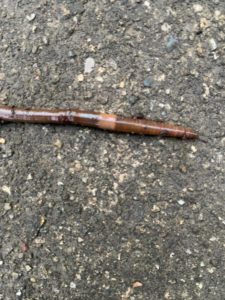Keeping your compost at the correct temperature is paramount to keeping invasive species like jumping worms out. Jumping worms, also called Alabama Jumpers, can be identified by their violent thrashing motions when touched, their dark gray/brown color, glossy and smooth bodies, and their pale-colored band that circles their entire body. Jumping worms can reproduce many times in a season without mating and their eggs will survive the Illinois winter which causes their presence in your compost difficult to get rid.

Jumping worms can cause ecosystem-scale changes by depleting the leaf litter layer which exposes soil to erosion. They consume the top layer of organic matter and quickly convert the soil into grainy castings which look like dry coffee grounds. Their presence changes the soil structure, depletes available nutrients, damages plant roots, and alters water holding capacity of the soil.
The best way to avoid getting jumping worms in your compost is to keep your compost at 104F. Thermometers are great tools to ensure the internal temperature of your compost is warm enough. To test if you have jumping worms currently in your soil or compost mix 1 gallon of water with 1/3 cup of ground yellow mustard seed. Clear a bare batch of soil and pour the solution slowly over the soil. The solution will irritate the worms and drive them to the surface where you can safely destroy them by placing them in a plastic bag in the sun for 10 minutes.
